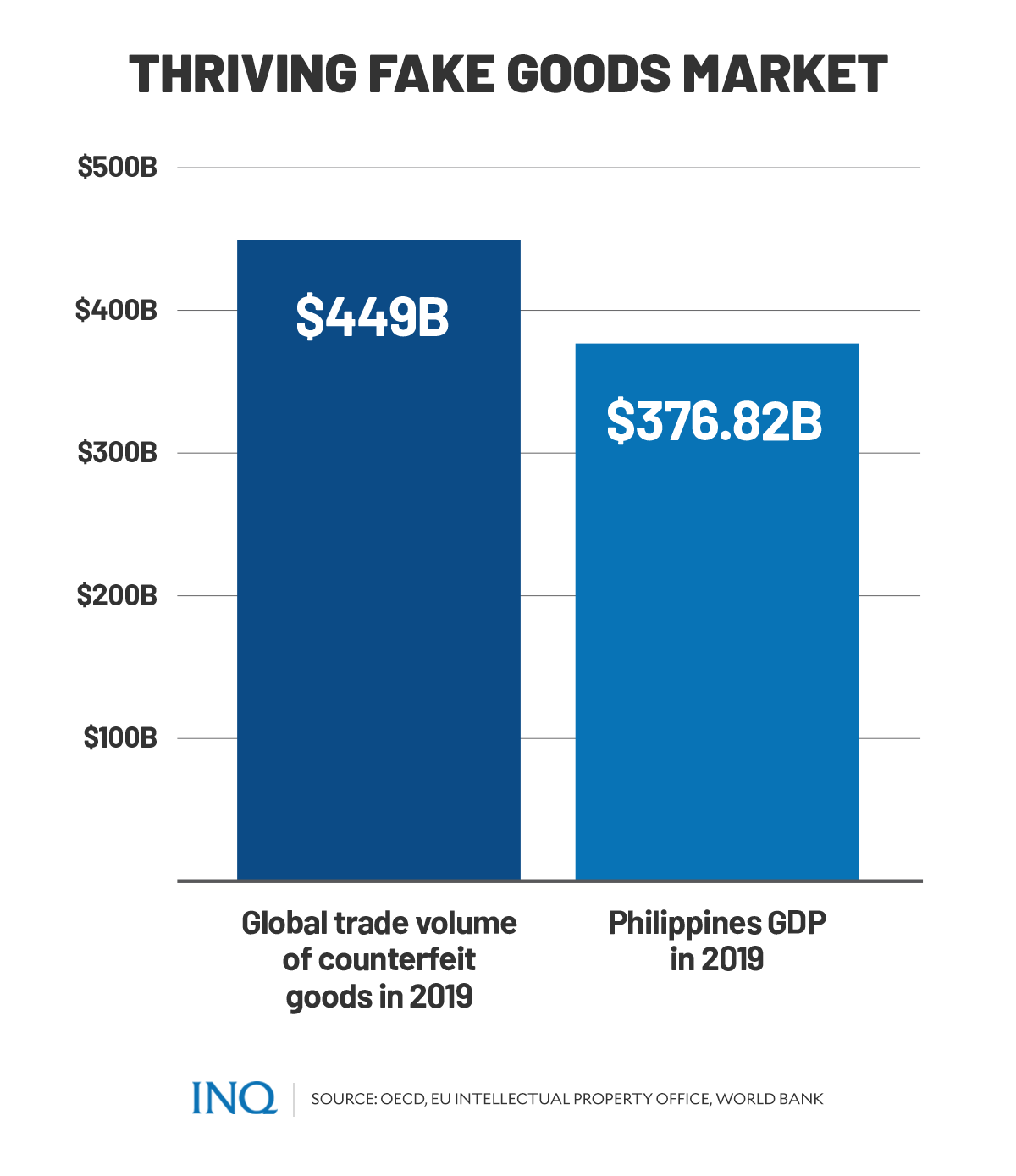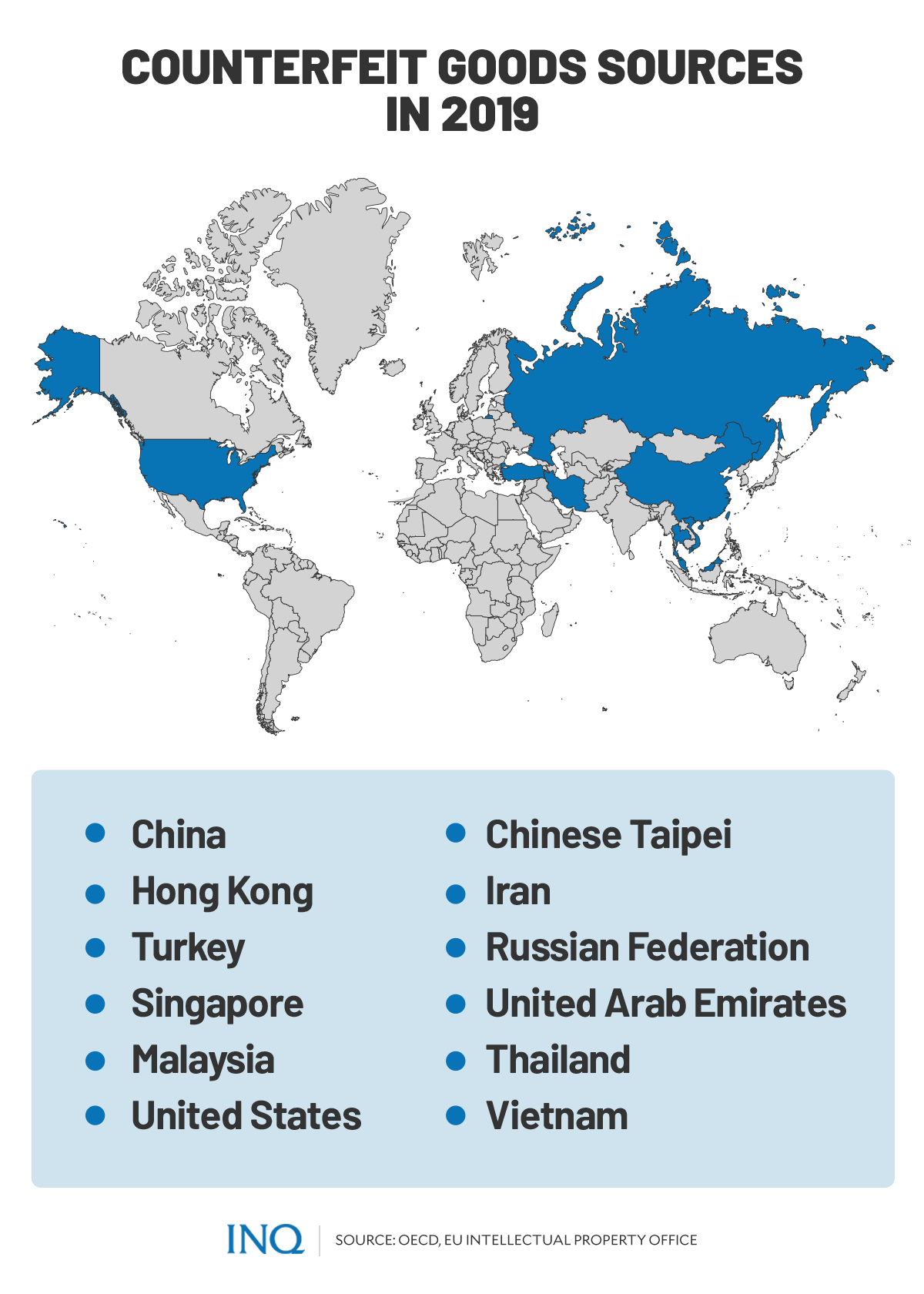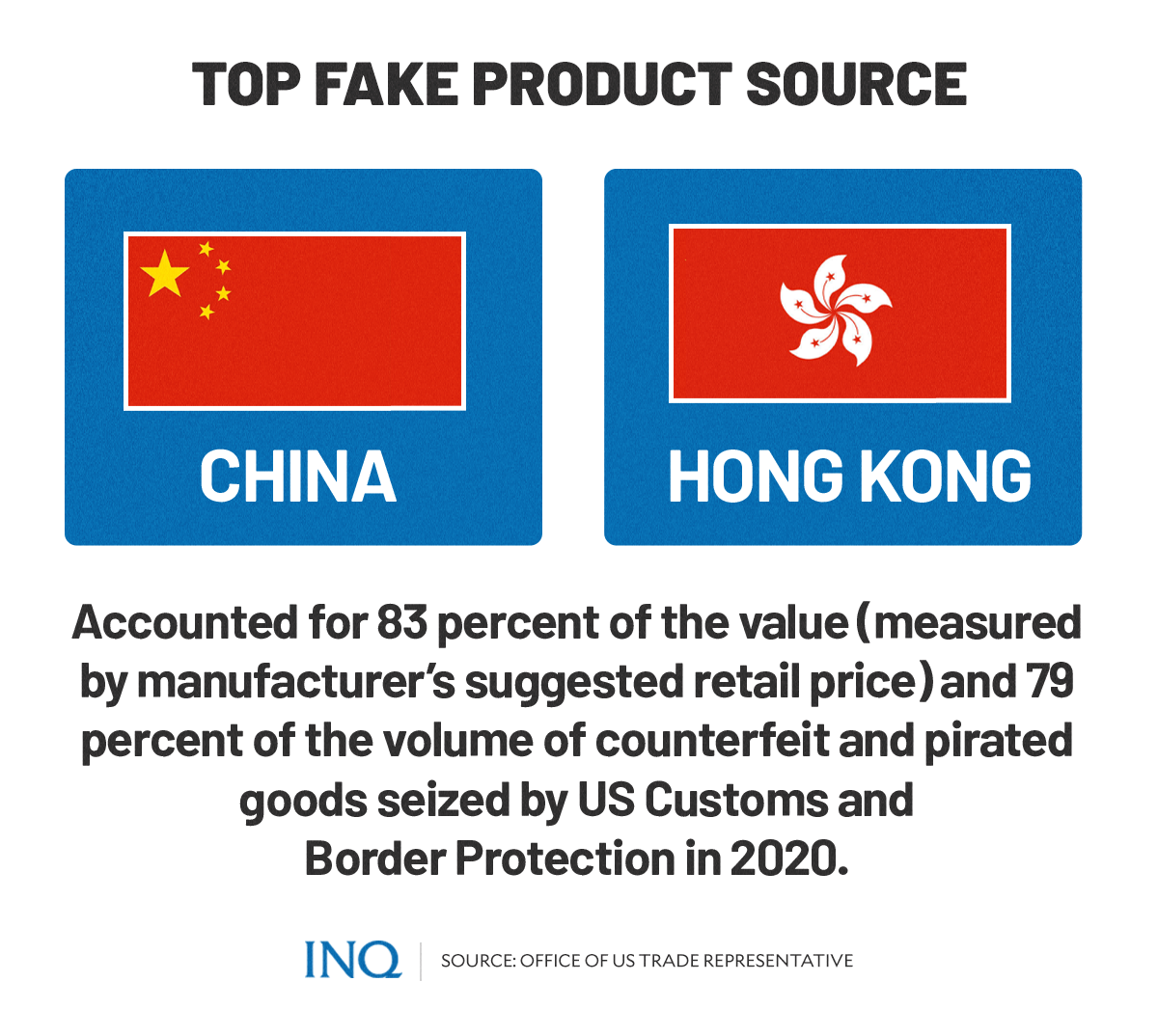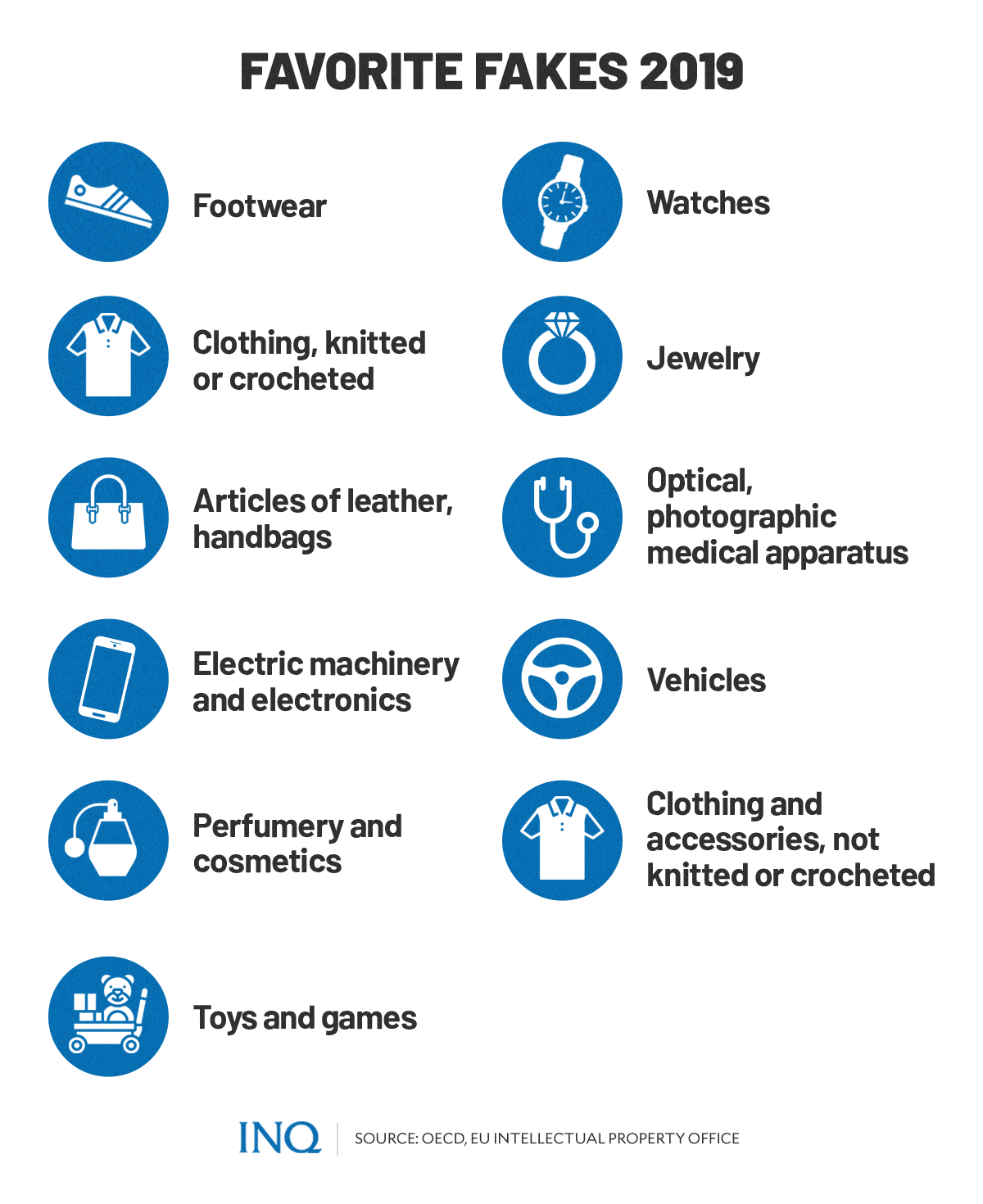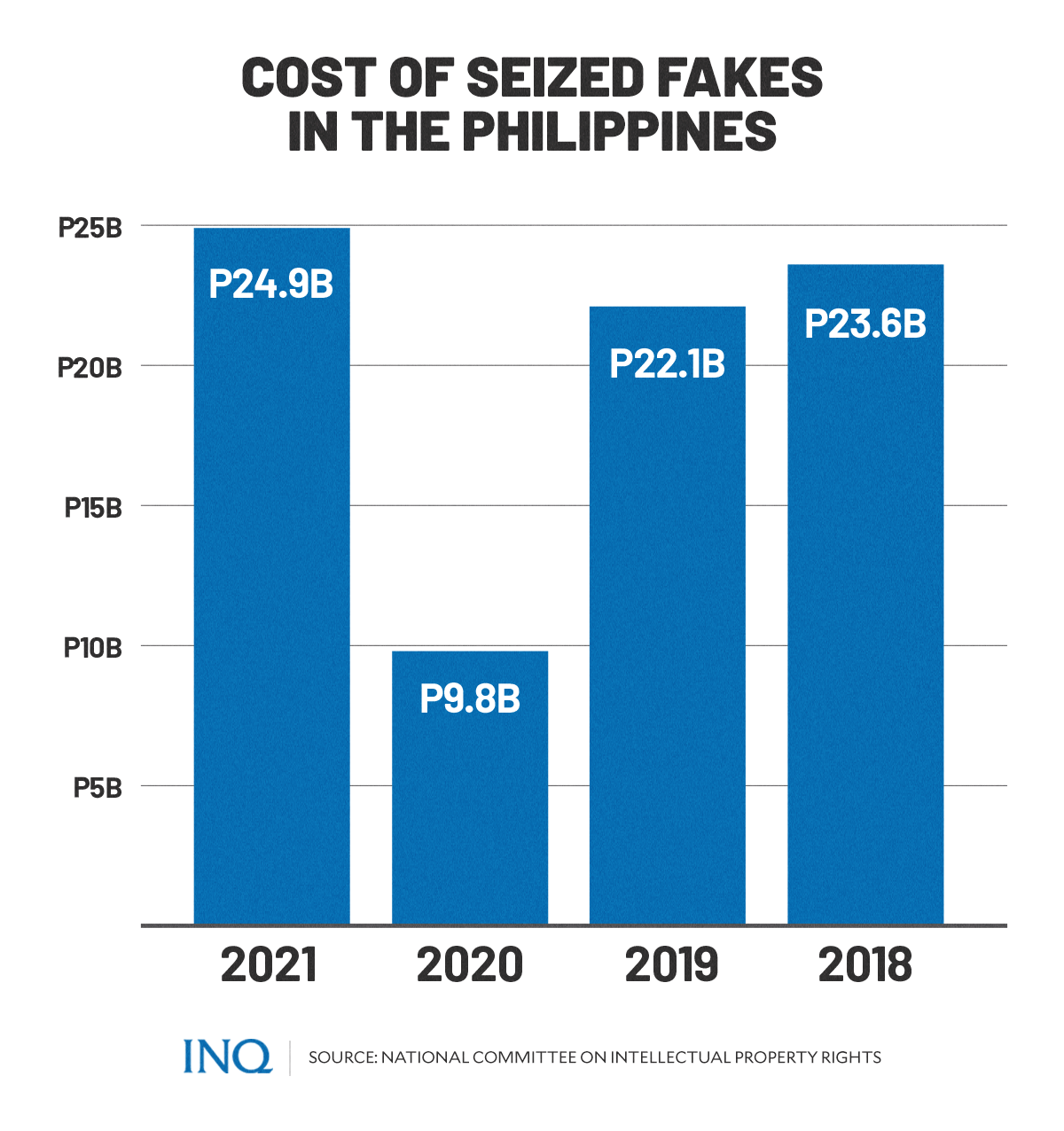China continues to rule counterfeit world as market for fake goods keeps growing
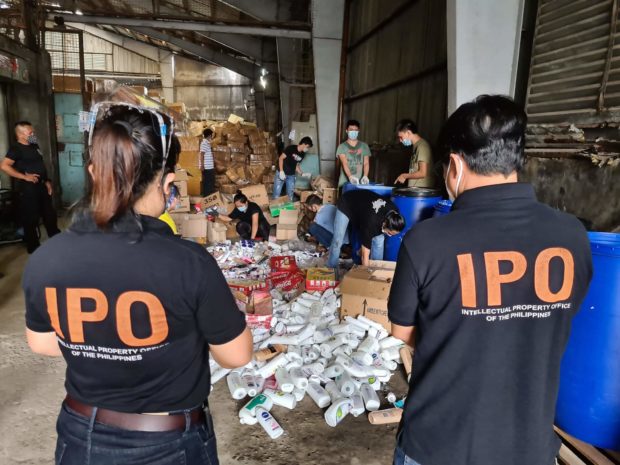
OFFICIALS of the Intellectual Property Office of the Philippines (IPO) join the Bureau of Customs in destroying counterfeit goods at a Bulacan warehouse in July 2021. The seized goods included fake Nikes, Adidas, Lacoste, Gucci, Victoria’s Secret, Jo Malone, Clinique and Dior. PHOTO FROM IPO
MANILA, Philippines—The world recently observed World Intellectual Property Day, but a dark scenario remains: The market for counterfeit goods continues to thrive—with China still being the top distributor of fake shoes, clothing, electronics, and other goods.
Counterfeiting, according to the Organisation for Economic Co-operation and Development (OECD), is an infringement of the legal rights of an owner of intellectual property.
Based on the World Trade Organization (WTO) Agreement on Trade-Related Aspects of Intellectual Property Rights (TRIPS)—the most comprehensive multilateral agreement on intellectual property—counterfeit trademark goods refer to:
“Any goods, including packaging, bearing without authorization a trademark which is identical to the trademark validly registered in respect of such goods, or which cannot be distinguished in its essential aspects from such a trademark, and which thereby infringes the rights of the owner of the trademark in question under the law of the country of importation.”
Meanwhile, pirated goods refer to “any goods which are copies made without the consent of the right holder or person duly authorized by the right holder in the country of production and which are made directly or indirectly from an article where the making of that copy would have constituted an infringement of a copyright or a related right under the law of the country of importation.”
Trading counterfeit and pirated goods are considered illegal and are against international intellectual property laws.
However, studies have shown that the legal trade remains bustling over the past few years, despite measures imposed by countries across the globe.
Thriving ‘fake goods market’
A report by the OECD and the European Union Intellectual Property Office (EUIPO) found that in 2019, the international trade in counterfeit and pirated goods amounted to roughly $449 billion or around P2.3 trillion.
OECD and EUIPO noted that the trade in counterfeit and pirated products rose steadily in the last few years “even as overall trade volumes stagnated.”
“Counterfeit trade takes away revenues from firms and governments and feeds other criminal activities. It can also jeopardize consumers’ health and safety,” said OECD Public Governance Director Marcos Bonturi.
An analysis conducted by consumer company Statista found that the fake goods market in 2019 was worth more than the gross domestic products (GDP) of select OECD countries and regions.
“Selling fake sneakers, watches and clothes is about as lucrative as running a mid-sized European country,” Florian Zandt, data journalist, wrote in a report published by Statista.
The market size for the trade of counterfeit products in 2019 was greater than the GDP of Ireland ($431B), Portugal ($372), and Israel ($362B) during the same year.
“Interestingly, the market size of the trade with fake goods is also in roughly the same ballpark as Hong Kong’s GDP of $466 billion, which is itself responsible for around 20 percent of the value of seized items between 2017 and 2019,” said Zandt.
READ: Fake Goods Market Worth More Than Ireland’s Economy
Although not included in Statista’s report, the market size of the fake goods trade was also larger than the GDP of the Philippines in 2019 which was around $376.8 billion, according to data from The World Bank.
In a report released last year, OECD and EUIPO estimated that the volume of international trade in counterfeit and pirated products went up further to $464 billion or P24.2 trillion in 2019 and was 2.5 percent of world trade.
Top distributors, victims
The OECD and EUIPO also found that in 2019, East Asia dominated the global trade in counterfeit and pirated goods—with China and Hong Kong at the top of the ranking.
“In that period, [Hong Kong] and China combined for almost 80 percent of volume and around 90 percent of value of the trade with fakes,” said Zandt.
Aside from China and Hong Kong, most volumes of counterfeit and pirated goods traded internationally also came from Turkey, Singapore, Malaysia, the United States, Taipei, Iran, Russia, United Arab Emirates, Thailand, and Vietnam.
A separate report released by the Office of the United States Trade Representative also identified China as the top global source of counterfeit products.
“China continues to be the number one source of counterfeit products in the world,” the US trade representative said in the 2021 Review of Notorious Markets for Counterfeiting and Piracy report.
“Counterfeit and pirated goods from China, together with transshipped goods from China to Hong Kong, accounted for 83 percent of the value (measured by manufacturer’s suggested retail price) and 79 percent of the volume of counterfeit and pirated goods seized by U.S. Customs and Border Protection (CBP) in 2020.”
In fact, the report identified nine physical markets in China that are considered large-scale distributors and sellers of counterfeit and pirated goods locally and internationally.
The US trade representative also identified Greenhills Shopping Center in San Juan, Metro Manila which the report said has many storefronts which sell counterfeit goods such as electronics, perfumes, watches, shoes, accessories, and fashion items.
“Although the Philippines government established an enforcement and monitoring agreement with the city of San Juan and created a working group composed of various agencies from the National Committee on Intellectual Property Rights and the Department of Information and Communications Technology, sellers of counterfeit goods are reportedly becoming bolder in displaying and openly discussing the illicit nature of the counterfeit goods, instead of discretely hiding the counterfeit goods under the tables as they did in the past,” the report stated.
The OECD-EUIPO also found the location of IP rights holders that suffer from counterfeiting and piracy. This refers to the place where the headquarters of a right holder is registered.
The study showed that the majority of companies whose IP rights are infringed upon by counterfeiters from 2017 to 2019 were from:
- United States: 39 percent
- France: 18 percent
- Germany: 16 percent
- Italy: 9.8 percent
- Switzerland: 4 percent
Other OECD countries whose companies also suffer from counterfeiting include Denmark, Japan, Korea, Spain, Ireland, and Sweden.
While China has been repeatedly identified as the top source of counterfeit and pirated goods, OECD and EUIPO found that some companies in the country who hold IP rights also became victims of counterfeiting.
“Remarkably, right holders in China and Hong Kong (China) also suffer from counterfeiting, as China and Hong Kong (China) rank 15th and 20th respectively in the list of economies most impacted by global counterfeiting and piracy,” the report said.
“This phenomenon is interesting as these regions are also the top provenance economies for counterfeited and pirated products,” it continued.
“This also indicates the strong threat that counterfeiting and piracy poses in undermining innovation within Chinese companies, since many of these companies rely on knowledge-based capital and IP rights in their business strategies.”
Among the top product categories most subject to counterfeiting and piracy in 2019 were:
- Footwear
- Clothing (knitted or crocheted)
- Articles of leather, handbags
- Electrical machinery and electronics
- Perfumery and cosmetics
- Toys and games
- Watches
- Jewelry
- Optical, photographic medical apparatus
- Vehicles
- Clothing and accessories (not knitted or crocheted)
Meanwhile, the top five industries commonly targeted by counterfeiters, based on 2019 data, were perfumery and cosmetics; articles of leather, handbags; clothing (knitted or crocheted); footwear; and watches.
PH gov’t and mountain of fake goods
In the Philippines, the value of counterfeit goods seized by the National Committee on Intellectual Property Rights (NCIPR) reached another record-high at P24.9 billion.
The figure was over two times more than the value recorded in 2020 which was P9.8 billion. In 2019, the NCIPR seized P22.1 billion worth of counterfeit goods in the country.
The latest figure also surpassed the then-record high P23.6 billion value of seized illicit items.
The figures were based on the estimated value of seized illicit items from operations and raids conducted by different agencies such as the National Bureau of Investigation (NBI), Philippine National Police (PNP), Optical Media Board (OMB), Bureau of Customs (BOC), Food and Drug Administration (FDA).
It also included figures from joint operations by BOC, PNP-Criminal Investigation and Detection Group (CIDG), Bureau of Internal Revenue (BIR), and Philippine Drug Enforcement Agency (PDEA).
Four months into 2022, the different government agencies have already seized hundreds of millions of pesos worth of counterfeit and pirated goods in different parts of the country.
On Tuesday, April 26, BOC seized P190 million worth of counterfeit goods in Valenzuela City.
Items recovered at the warehouse included imported kitchenware, housewares, Intellectual Property Rights (IPR) infringing goods, and foodstuff, among others, which were estimated to be worth P190 million.
READ: P190M worth of counterfeit goods seized in Valenzuela
Last month, BOC seized some P100 million worth of smuggled counterfeit goods during a raid at a warehouse also located in Valenzuela City.
Among the seized items were used clothing (ukay-ukay), footwear of known trademarks such as Nike, Crocs, Sandugo, and other counterfeit items.
The smuggled goods came from China and Bangladesh, the BOC said.
The agency also recently seized 690 master cases of smuggled cigarettes valued at P20 million during a buy-bust operation.
